Managerial Finance Report: Marks & Spencer vs Next Plc Analysis
VerifiedAdded on 2022/12/02
|21
|3903
|192
Report
AI Summary
This managerial finance report presents a financial analysis of two leading UK retail supermarket chains, Marks and Spencer Plc and Next Plc. The report begins with an overview of both companies, detailing their operations and market presence. It then proceeds to a comprehensive ratio analysis, comparing key financial metrics such as current ratio, quick ratio, gross profit ratio, net profit ratio, P/E ratio, gearing ratio, return on capital employed, inventory turnover, dividend payout ratio, and earnings per share for both companies over a two-year period. Interpretations of these ratios are provided, highlighting the strengths and weaknesses of each company's financial performance. The report also includes recommendations for both companies to improve their financial positions. Furthermore, the report delves into investment appraisal techniques, specifically net present value (NPV), applied to hypothetical projects, along with a discussion of the limitations of these techniques in long-term decision-making. The conclusion summarizes the key findings and recommendations, providing a holistic view of the financial health and investment strategies of the companies analyzed.
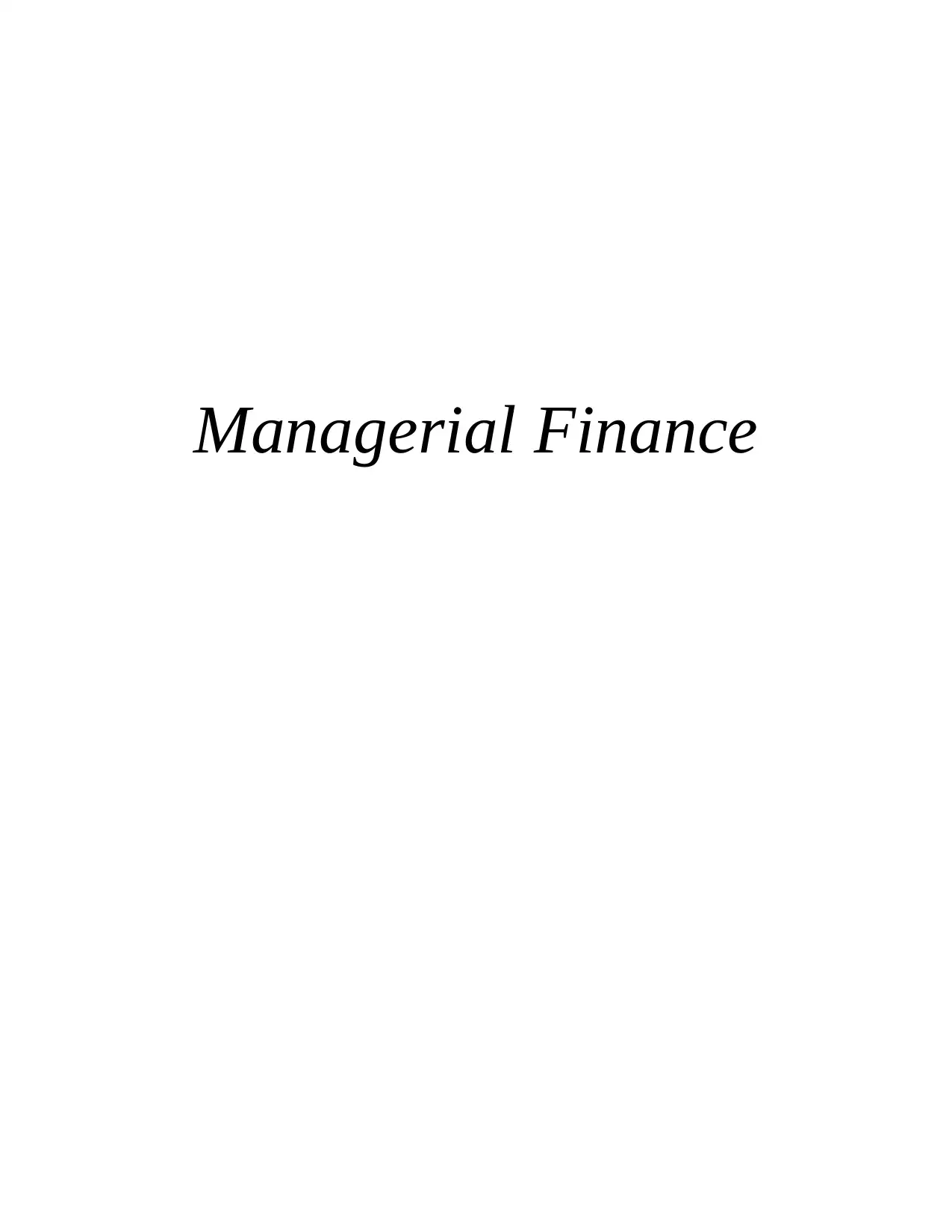
Managerial Finance
Paraphrase This Document
Need a fresh take? Get an instant paraphrase of this document with our AI Paraphraser
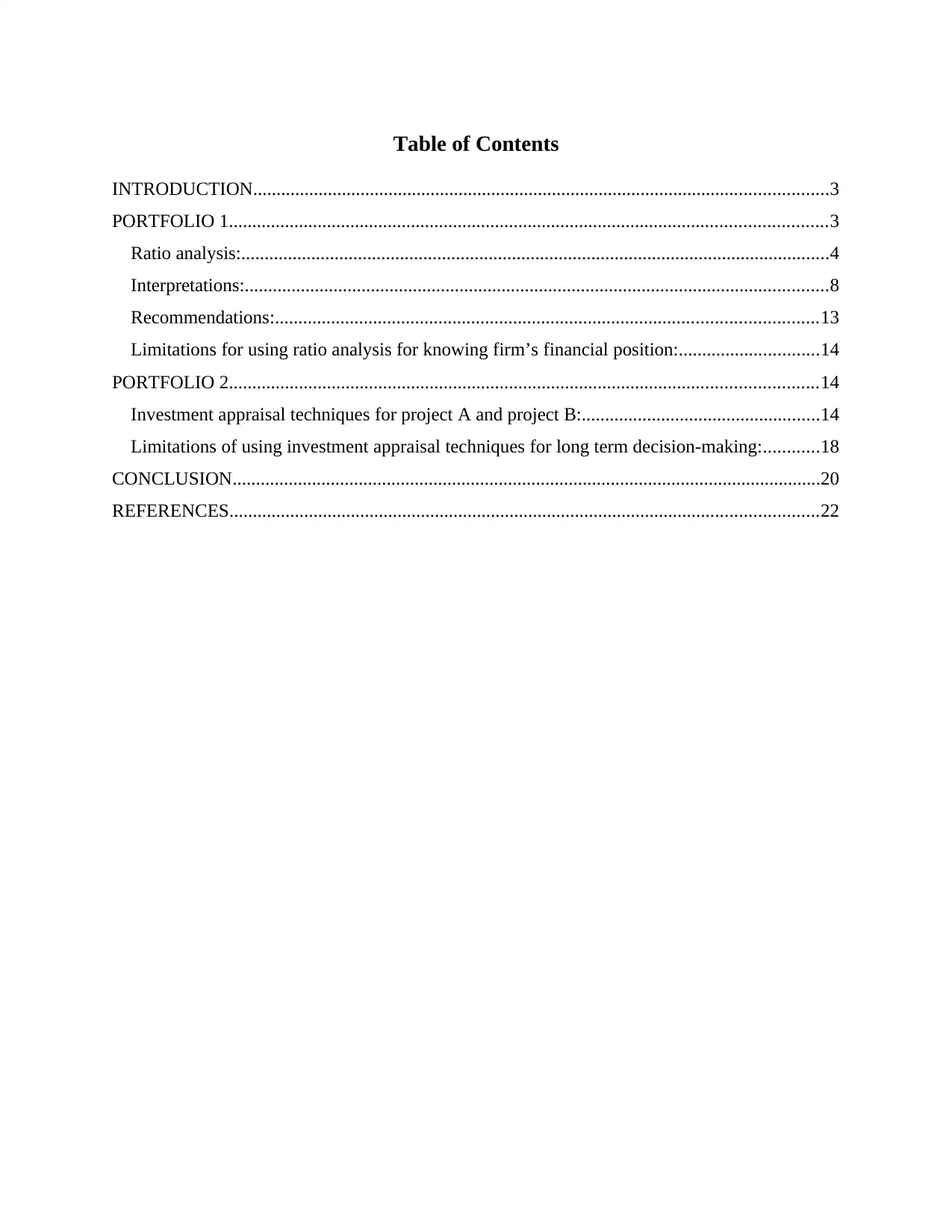
Table of Contents
INTRODUCTION...........................................................................................................................3
PORTFOLIO 1................................................................................................................................3
Ratio analysis:..............................................................................................................................4
Interpretations:.............................................................................................................................8
Recommendations:....................................................................................................................13
Limitations for using ratio analysis for knowing firm’s financial position:..............................14
PORTFOLIO 2..............................................................................................................................14
Investment appraisal techniques for project A and project B:...................................................14
Limitations of using investment appraisal techniques for long term decision-making:............18
CONCLUSION..............................................................................................................................20
REFERENCES..............................................................................................................................22
INTRODUCTION...........................................................................................................................3
PORTFOLIO 1................................................................................................................................3
Ratio analysis:..............................................................................................................................4
Interpretations:.............................................................................................................................8
Recommendations:....................................................................................................................13
Limitations for using ratio analysis for knowing firm’s financial position:..............................14
PORTFOLIO 2..............................................................................................................................14
Investment appraisal techniques for project A and project B:...................................................14
Limitations of using investment appraisal techniques for long term decision-making:............18
CONCLUSION..............................................................................................................................20
REFERENCES..............................................................................................................................22
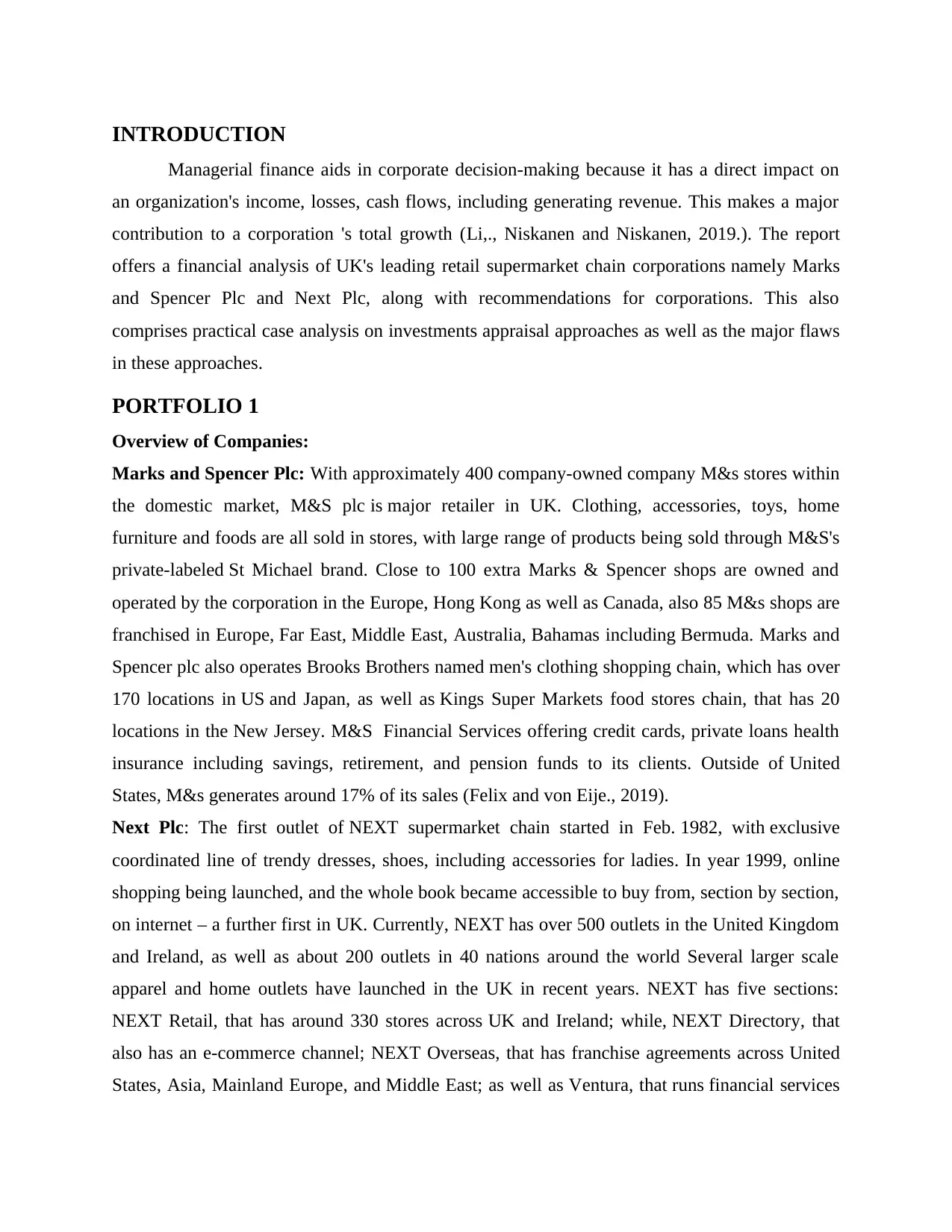
INTRODUCTION
Managerial finance aids in corporate decision-making because it has a direct impact on
an organization's income, losses, cash flows, including generating revenue. This makes a major
contribution to a corporation 's total growth (Li,., Niskanen and Niskanen, 2019.). The report
offers a financial analysis of UK's leading retail supermarket chain corporations namely Marks
and Spencer Plc and Next Plc, along with recommendations for corporations. This also
comprises practical case analysis on investments appraisal approaches as well as the major flaws
in these approaches.
PORTFOLIO 1
Overview of Companies:
Marks and Spencer Plc: With approximately 400 company-owned company M&s stores within
the domestic market, M&S plc is major retailer in UK. Clothing, accessories, toys, home
furniture and foods are all sold in stores, with large range of products being sold through M&S's
private-labeled St Michael brand. Close to 100 extra Marks & Spencer shops are owned and
operated by the corporation in the Europe, Hong Kong as well as Canada, also 85 M&s shops are
franchised in Europe, Far East, Middle East, Australia, Bahamas including Bermuda. Marks and
Spencer plc also operates Brooks Brothers named men's clothing shopping chain, which has over
170 locations in US and Japan, as well as Kings Super Markets food stores chain, that has 20
locations in the New Jersey. M&S Financial Services offering credit cards, private loans health
insurance including savings, retirement, and pension funds to its clients. Outside of United
States, M&s generates around 17% of its sales (Felix and von Eije., 2019).
Next Plc: The first outlet of NEXT supermarket chain started in Feb. 1982, with exclusive
coordinated line of trendy dresses, shoes, including accessories for ladies. In year 1999, online
shopping being launched, and the whole book became accessible to buy from, section by section,
on internet – a further first in UK. Currently, NEXT has over 500 outlets in the United Kingdom
and Ireland, as well as about 200 outlets in 40 nations around the world Several larger scale
apparel and home outlets have launched in the UK in recent years. NEXT has five sections:
NEXT Retail, that has around 330 stores across UK and Ireland; while, NEXT Directory, that
also has an e-commerce channel; NEXT Overseas, that has franchise agreements across United
States, Asia, Mainland Europe, and Middle East; as well as Ventura, that runs financial services
Managerial finance aids in corporate decision-making because it has a direct impact on
an organization's income, losses, cash flows, including generating revenue. This makes a major
contribution to a corporation 's total growth (Li,., Niskanen and Niskanen, 2019.). The report
offers a financial analysis of UK's leading retail supermarket chain corporations namely Marks
and Spencer Plc and Next Plc, along with recommendations for corporations. This also
comprises practical case analysis on investments appraisal approaches as well as the major flaws
in these approaches.
PORTFOLIO 1
Overview of Companies:
Marks and Spencer Plc: With approximately 400 company-owned company M&s stores within
the domestic market, M&S plc is major retailer in UK. Clothing, accessories, toys, home
furniture and foods are all sold in stores, with large range of products being sold through M&S's
private-labeled St Michael brand. Close to 100 extra Marks & Spencer shops are owned and
operated by the corporation in the Europe, Hong Kong as well as Canada, also 85 M&s shops are
franchised in Europe, Far East, Middle East, Australia, Bahamas including Bermuda. Marks and
Spencer plc also operates Brooks Brothers named men's clothing shopping chain, which has over
170 locations in US and Japan, as well as Kings Super Markets food stores chain, that has 20
locations in the New Jersey. M&S Financial Services offering credit cards, private loans health
insurance including savings, retirement, and pension funds to its clients. Outside of United
States, M&s generates around 17% of its sales (Felix and von Eije., 2019).
Next Plc: The first outlet of NEXT supermarket chain started in Feb. 1982, with exclusive
coordinated line of trendy dresses, shoes, including accessories for ladies. In year 1999, online
shopping being launched, and the whole book became accessible to buy from, section by section,
on internet – a further first in UK. Currently, NEXT has over 500 outlets in the United Kingdom
and Ireland, as well as about 200 outlets in 40 nations around the world Several larger scale
apparel and home outlets have launched in the UK in recent years. NEXT has five sections:
NEXT Retail, that has around 330 stores across UK and Ireland; while, NEXT Directory, that
also has an e-commerce channel; NEXT Overseas, that has franchise agreements across United
States, Asia, Mainland Europe, and Middle East; as well as Ventura, that runs financial services
⊘ This is a preview!⊘
Do you want full access?
Subscribe today to unlock all pages.

Trusted by 1+ million students worldwide
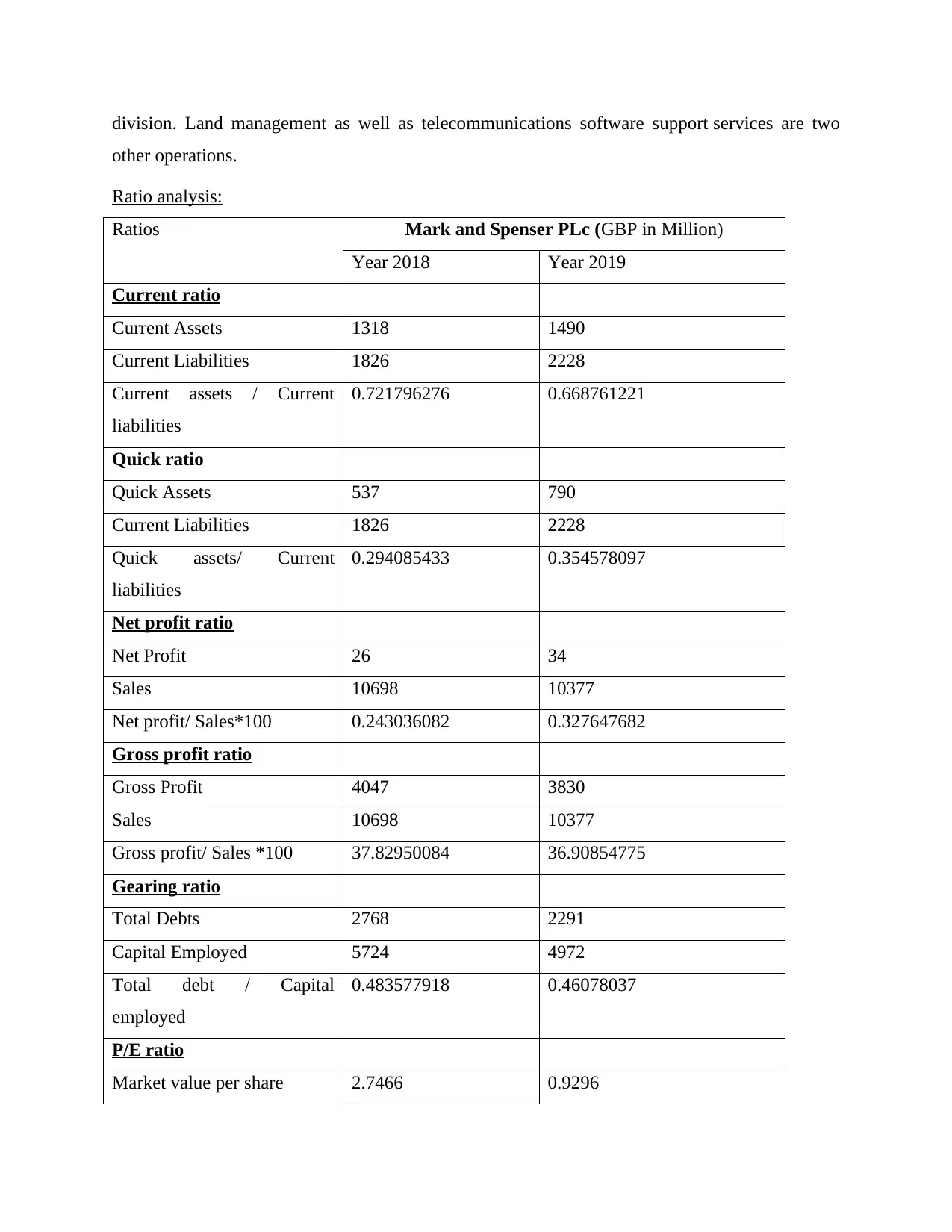
division. Land management as well as telecommunications software support services are two
other operations.
Ratio analysis:
Ratios Mark and Spenser PLc (GBP in Million)
Year 2018 Year 2019
Current ratio
Current Assets 1318 1490
Current Liabilities 1826 2228
Current assets / Current
liabilities
0.721796276 0.668761221
Quick ratio
Quick Assets 537 790
Current Liabilities 1826 2228
Quick assets/ Current
liabilities
0.294085433 0.354578097
Net profit ratio
Net Profit 26 34
Sales 10698 10377
Net profit/ Sales*100 0.243036082 0.327647682
Gross profit ratio
Gross Profit 4047 3830
Sales 10698 10377
Gross profit/ Sales *100 37.82950084 36.90854775
Gearing ratio
Total Debts 2768 2291
Capital Employed 5724 4972
Total debt / Capital
employed
0.483577918 0.46078037
P/E ratio
Market value per share 2.7466 0.9296
other operations.
Ratio analysis:
Ratios Mark and Spenser PLc (GBP in Million)
Year 2018 Year 2019
Current ratio
Current Assets 1318 1490
Current Liabilities 1826 2228
Current assets / Current
liabilities
0.721796276 0.668761221
Quick ratio
Quick Assets 537 790
Current Liabilities 1826 2228
Quick assets/ Current
liabilities
0.294085433 0.354578097
Net profit ratio
Net Profit 26 34
Sales 10698 10377
Net profit/ Sales*100 0.243036082 0.327647682
Gross profit ratio
Gross Profit 4047 3830
Sales 10698 10377
Gross profit/ Sales *100 37.82950084 36.90854775
Gearing ratio
Total Debts 2768 2291
Capital Employed 5724 4972
Total debt / Capital
employed
0.483577918 0.46078037
P/E ratio
Market value per share 2.7466 0.9296
Paraphrase This Document
Need a fresh take? Get an instant paraphrase of this document with our AI Paraphraser
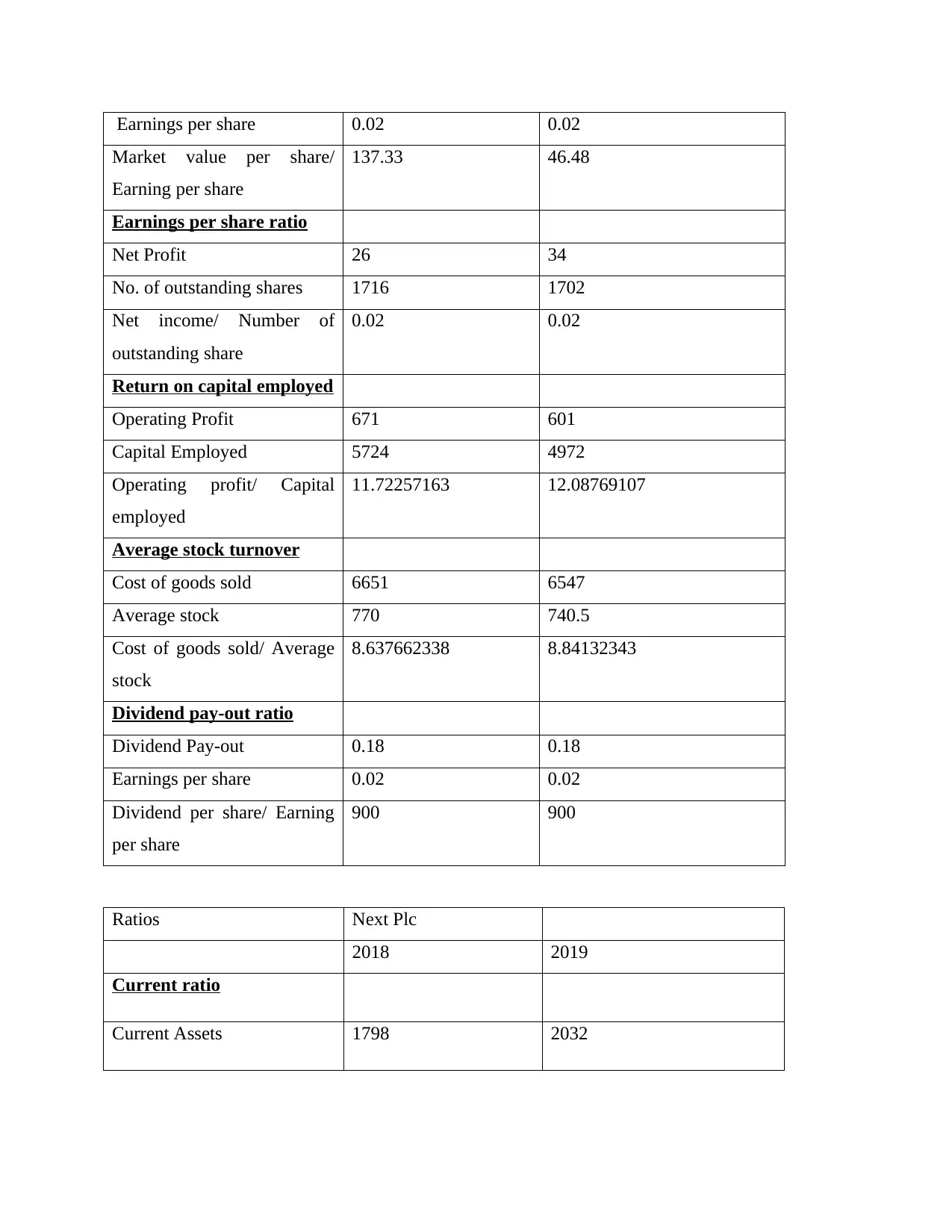
Earnings per share 0.02 0.02
Market value per share/
Earning per share
137.33 46.48
Earnings per share ratio
Net Profit 26 34
No. of outstanding shares 1716 1702
Net income/ Number of
outstanding share
0.02 0.02
Return on capital employed
Operating Profit 671 601
Capital Employed 5724 4972
Operating profit/ Capital
employed
11.72257163 12.08769107
Average stock turnover
Cost of goods sold 6651 6547
Average stock 770 740.5
Cost of goods sold/ Average
stock
8.637662338 8.84132343
Dividend pay-out ratio
Dividend Pay-out 0.18 0.18
Earnings per share 0.02 0.02
Dividend per share/ Earning
per share
900 900
Ratios Next Plc
2018 2019
Current ratio
Current Assets 1798 2032
Market value per share/
Earning per share
137.33 46.48
Earnings per share ratio
Net Profit 26 34
No. of outstanding shares 1716 1702
Net income/ Number of
outstanding share
0.02 0.02
Return on capital employed
Operating Profit 671 601
Capital Employed 5724 4972
Operating profit/ Capital
employed
11.72257163 12.08769107
Average stock turnover
Cost of goods sold 6651 6547
Average stock 770 740.5
Cost of goods sold/ Average
stock
8.637662338 8.84132343
Dividend pay-out ratio
Dividend Pay-out 0.18 0.18
Earnings per share 0.02 0.02
Dividend per share/ Earning
per share
900 900
Ratios Next Plc
2018 2019
Current ratio
Current Assets 1798 2032
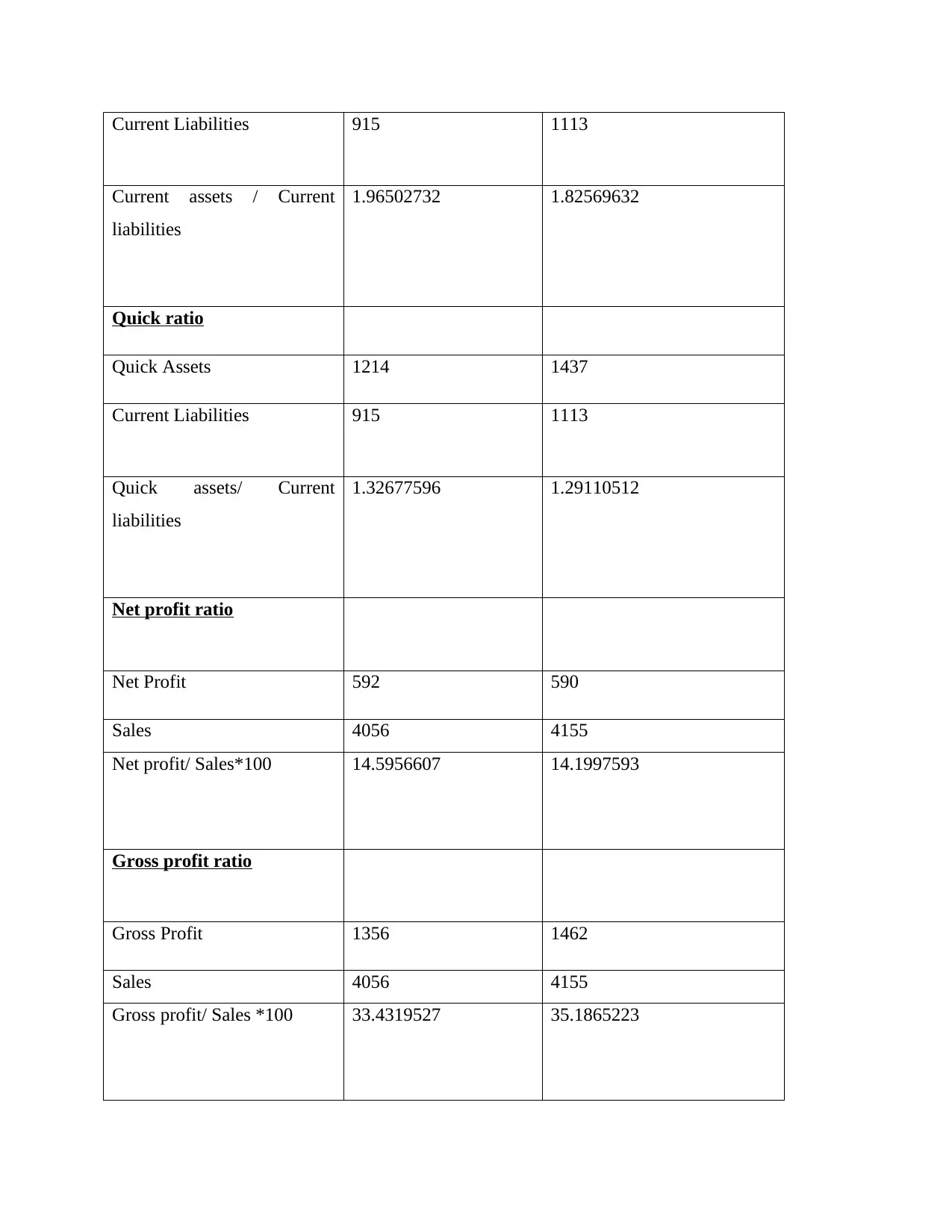
Current Liabilities 915 1113
Current assets / Current
liabilities
1.96502732 1.82569632
Quick ratio
Quick Assets 1214 1437
Current Liabilities 915 1113
Quick assets/ Current
liabilities
1.32677596 1.29110512
Net profit ratio
Net Profit 592 590
Sales 4056 4155
Net profit/ Sales*100 14.5956607 14.1997593
Gross profit ratio
Gross Profit 1356 1462
Sales 4056 4155
Gross profit/ Sales *100 33.4319527 35.1865223
Current assets / Current
liabilities
1.96502732 1.82569632
Quick ratio
Quick Assets 1214 1437
Current Liabilities 915 1113
Quick assets/ Current
liabilities
1.32677596 1.29110512
Net profit ratio
Net Profit 592 590
Sales 4056 4155
Net profit/ Sales*100 14.5956607 14.1997593
Gross profit ratio
Gross Profit 1356 1462
Sales 4056 4155
Gross profit/ Sales *100 33.4319527 35.1865223
⊘ This is a preview!⊘
Do you want full access?
Subscribe today to unlock all pages.

Trusted by 1+ million students worldwide

Gearing ratio
Total Debts 1164 1145
Capital Employed 1647 1698
Total debt / Capital employed 0.70673953 0.67432273
P/E ratio
Market value per share 39.1872 68.5279
Earnings per share 4.16 4.39
Market value per share/
Earning per share
9.42 15.61
Earnings per share ratio
Net Profit 592 590
No. of outstanding shares 142 136
Net income/ Number of
outstanding share
4.16901408 4.33823529
Return on capital employed
Operating Profit 760 749
Capital Employed 1647 1698
Operating profit/ Capital
employed
46.1445052 44.1107185
Total Debts 1164 1145
Capital Employed 1647 1698
Total debt / Capital employed 0.70673953 0.67432273
P/E ratio
Market value per share 39.1872 68.5279
Earnings per share 4.16 4.39
Market value per share/
Earning per share
9.42 15.61
Earnings per share ratio
Net Profit 592 590
No. of outstanding shares 142 136
Net income/ Number of
outstanding share
4.16901408 4.33823529
Return on capital employed
Operating Profit 760 749
Capital Employed 1647 1698
Operating profit/ Capital
employed
46.1445052 44.1107185
Paraphrase This Document
Need a fresh take? Get an instant paraphrase of this document with our AI Paraphraser

Average stock turnover
Cost of goods sold 2699 2693
Average stock 470.5 496.5
Cost of goods sold/ Average
stock
5.73645058 5.42396777
Dividend pay-out ratio
Dividend Pay-out 1.58 1.6
Earnings per share 4.16 4.39
Dividend per share/ Earning
per share
37.9807692 36.4464692
Interpretations:
Current ratio:
Analysis based on the above graph and current ratio of Next Plc and M&S Plc shows that
Net Plc has higher current ratio as compare to M&S plc. There is declining trend in ratio of both
these companies. Reported declining trend in both companies’ current ratio shows that
companies’ short term liquidity position has been decreased. But Next Plc with greater current
ratio has better short-term liquidity position (Zhang and e. al., 2019).
Cost of goods sold 2699 2693
Average stock 470.5 496.5
Cost of goods sold/ Average
stock
5.73645058 5.42396777
Dividend pay-out ratio
Dividend Pay-out 1.58 1.6
Earnings per share 4.16 4.39
Dividend per share/ Earning
per share
37.9807692 36.4464692
Interpretations:
Current ratio:
Analysis based on the above graph and current ratio of Next Plc and M&S Plc shows that
Net Plc has higher current ratio as compare to M&S plc. There is declining trend in ratio of both
these companies. Reported declining trend in both companies’ current ratio shows that
companies’ short term liquidity position has been decreased. But Next Plc with greater current
ratio has better short-term liquidity position (Zhang and e. al., 2019).

Quick Ratio:
The analysis of Quick ratio of shows that Next plc’s quick ratios are 1.33 and 1.29
respectively during 2018 and 2019 reflecting decline in ratio trend. While M&S plc has reported
quick ratio of 0.29 and 0.35 with an increase during 2018 and 2019 respectively. Comparatively
Next plc with higher quick ratio has more efficient cash liquidity position as compare to M&S
plc.
Gross profit ratio:
As shows in graph Gross Profit Ratio of M&S plc are 37.83% and 36.91% during 2018
and 2019 while of Next Plc is 33.43% and 35.19% for the same period. There is significant
The analysis of Quick ratio of shows that Next plc’s quick ratios are 1.33 and 1.29
respectively during 2018 and 2019 reflecting decline in ratio trend. While M&S plc has reported
quick ratio of 0.29 and 0.35 with an increase during 2018 and 2019 respectively. Comparatively
Next plc with higher quick ratio has more efficient cash liquidity position as compare to M&S
plc.
Gross profit ratio:
As shows in graph Gross Profit Ratio of M&S plc are 37.83% and 36.91% during 2018
and 2019 while of Next Plc is 33.43% and 35.19% for the same period. There is significant
⊘ This is a preview!⊘
Do you want full access?
Subscribe today to unlock all pages.

Trusted by 1+ million students worldwide
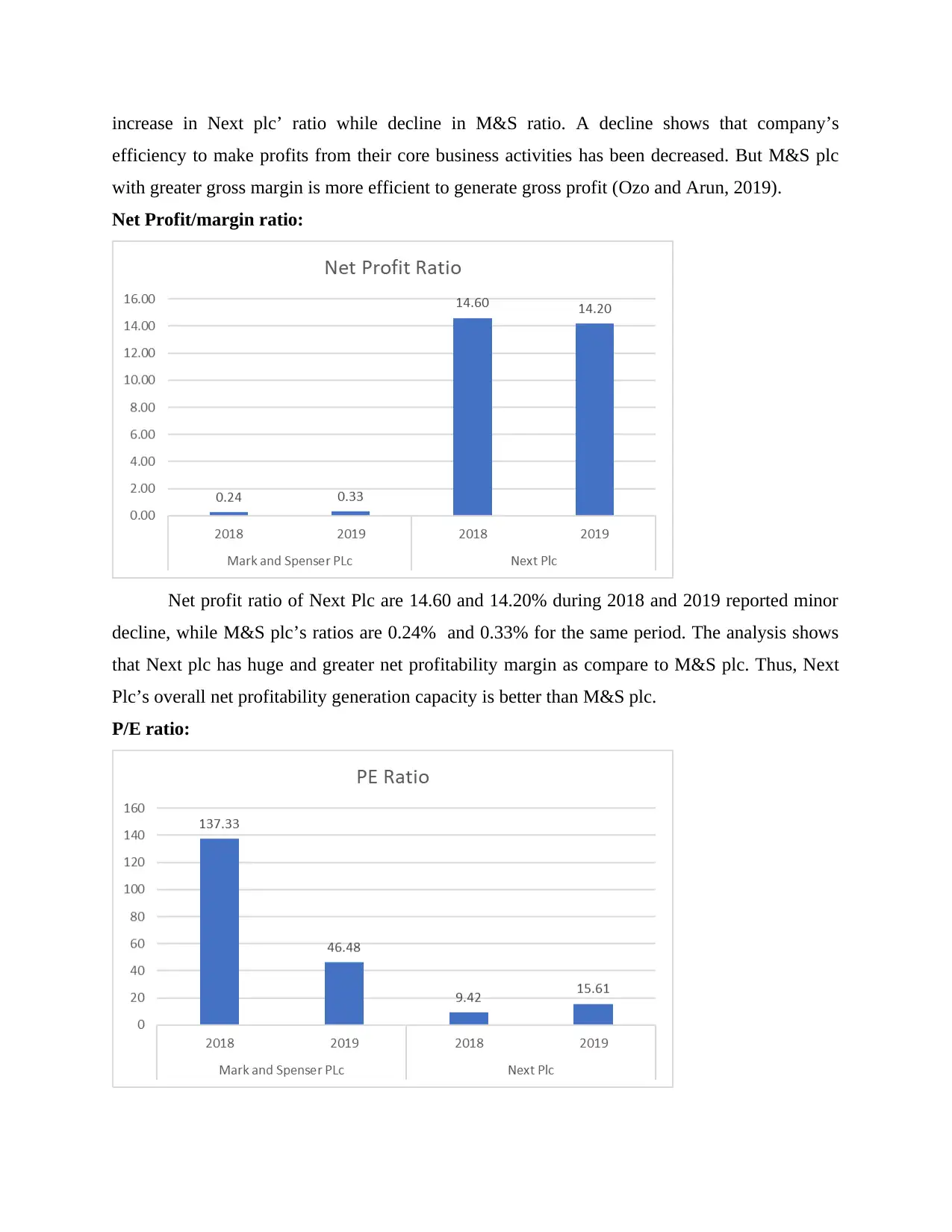
increase in Next plc’ ratio while decline in M&S ratio. A decline shows that company’s
efficiency to make profits from their core business activities has been decreased. But M&S plc
with greater gross margin is more efficient to generate gross profit (Ozo and Arun, 2019).
Net Profit/margin ratio:
Net profit ratio of Next Plc are 14.60 and 14.20% during 2018 and 2019 reported minor
decline, while M&S plc’s ratios are 0.24% and 0.33% for the same period. The analysis shows
that Next plc has huge and greater net profitability margin as compare to M&S plc. Thus, Next
Plc’s overall net profitability generation capacity is better than M&S plc.
P/E ratio:
efficiency to make profits from their core business activities has been decreased. But M&S plc
with greater gross margin is more efficient to generate gross profit (Ozo and Arun, 2019).
Net Profit/margin ratio:
Net profit ratio of Next Plc are 14.60 and 14.20% during 2018 and 2019 reported minor
decline, while M&S plc’s ratios are 0.24% and 0.33% for the same period. The analysis shows
that Next plc has huge and greater net profitability margin as compare to M&S plc. Thus, Next
Plc’s overall net profitability generation capacity is better than M&S plc.
P/E ratio:
Paraphrase This Document
Need a fresh take? Get an instant paraphrase of this document with our AI Paraphraser

PE ratio of M&S plc are 137.33 and 46.48 and of Next Plc are just 9.42 and 15.61
respectively for year 2018 and 2019. Next plc reported increase but M&S plc with higher PE
ratio is more efficient to provide return to each of their shareholder (Basuki, Hidayat and
Budiwitjaksono, 2020).
Capital gearing ratio:
Next Plc’s gearing ratios are 0.71 and 0.67 for 2018 and 2019 while of M&S plc is 0.48
and 0.46. Thus M&S plc with lower gearing ratio has more effective capital structure with less
debts as compare to Next Plc.
Return on capital employed ratio:
respectively for year 2018 and 2019. Next plc reported increase but M&S plc with higher PE
ratio is more efficient to provide return to each of their shareholder (Basuki, Hidayat and
Budiwitjaksono, 2020).
Capital gearing ratio:
Next Plc’s gearing ratios are 0.71 and 0.67 for 2018 and 2019 while of M&S plc is 0.48
and 0.46. Thus M&S plc with lower gearing ratio has more effective capital structure with less
debts as compare to Next Plc.
Return on capital employed ratio:
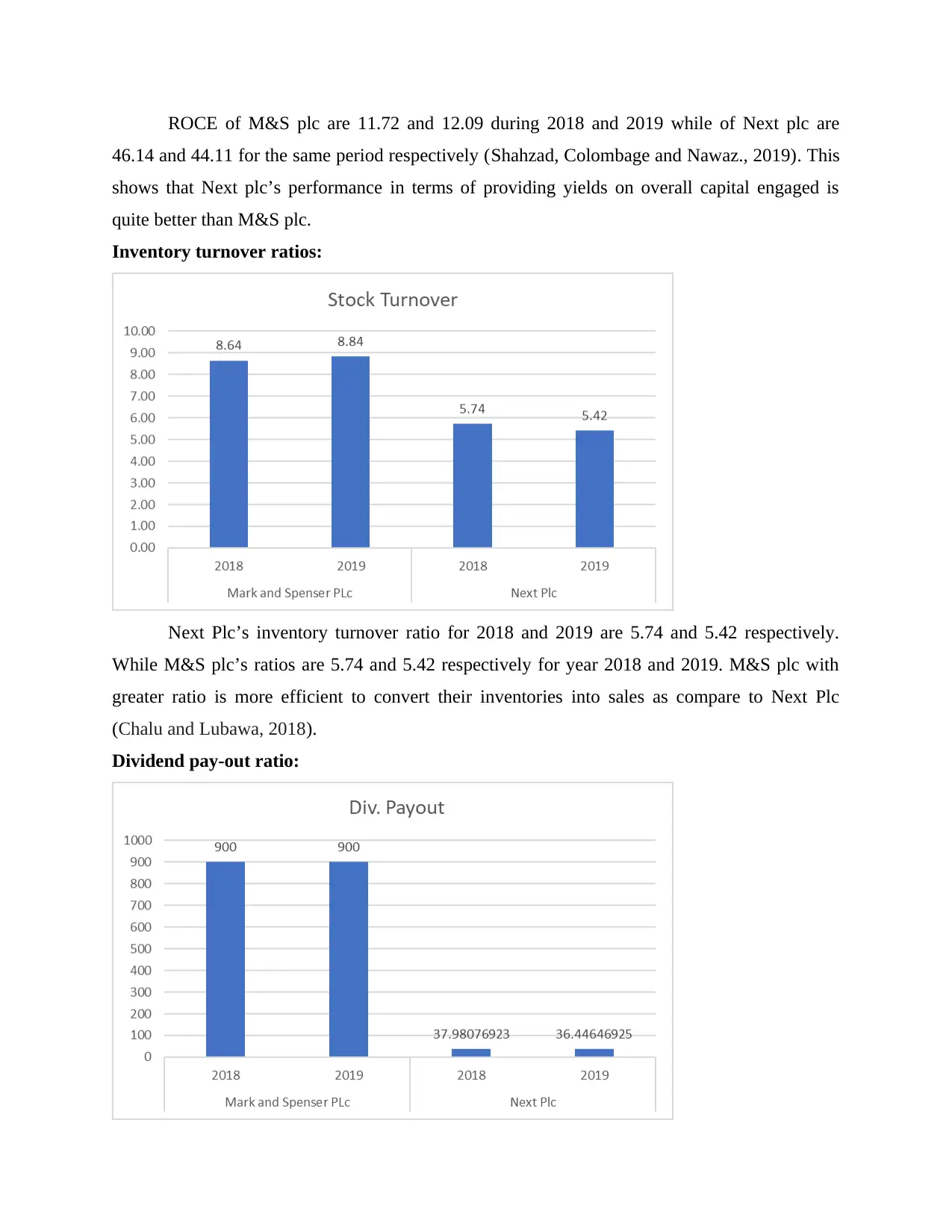
ROCE of M&S plc are 11.72 and 12.09 during 2018 and 2019 while of Next plc are
46.14 and 44.11 for the same period respectively (Shahzad, Colombage and Nawaz., 2019). This
shows that Next plc’s performance in terms of providing yields on overall capital engaged is
quite better than M&S plc.
Inventory turnover ratios:
Next Plc’s inventory turnover ratio for 2018 and 2019 are 5.74 and 5.42 respectively.
While M&S plc’s ratios are 5.74 and 5.42 respectively for year 2018 and 2019. M&S plc with
greater ratio is more efficient to convert their inventories into sales as compare to Next Plc
(Chalu and Lubawa, 2018).
Dividend pay-out ratio:
46.14 and 44.11 for the same period respectively (Shahzad, Colombage and Nawaz., 2019). This
shows that Next plc’s performance in terms of providing yields on overall capital engaged is
quite better than M&S plc.
Inventory turnover ratios:
Next Plc’s inventory turnover ratio for 2018 and 2019 are 5.74 and 5.42 respectively.
While M&S plc’s ratios are 5.74 and 5.42 respectively for year 2018 and 2019. M&S plc with
greater ratio is more efficient to convert their inventories into sales as compare to Next Plc
(Chalu and Lubawa, 2018).
Dividend pay-out ratio:
⊘ This is a preview!⊘
Do you want full access?
Subscribe today to unlock all pages.

Trusted by 1+ million students worldwide
1 out of 21
Related Documents
Your All-in-One AI-Powered Toolkit for Academic Success.
+13062052269
info@desklib.com
Available 24*7 on WhatsApp / Email
![[object Object]](/_next/static/media/star-bottom.7253800d.svg)
Unlock your academic potential
Copyright © 2020–2025 A2Z Services. All Rights Reserved. Developed and managed by ZUCOL.





